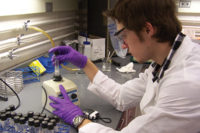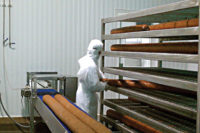Someone who has never been through a recall doesn’t truly understand how costly even a small mistake can be. According to a New Jersey PIRG study, food recalls and foodborne illnesses cost approximately $77 billion each year in the United States alone . This cost includes discarded product, lost revenue, lost wages, health-care costs and litigation; however, it does not begin to measure the damage it can do to a company’s reputation.
Food safety after the fact is too late
The big secret about food safety is that unsafe food really isn’t about food — it’s the steps you take to process it. Developing a corporate culture focused on quality and responsibility at each step of the process is essential to building a successful food-safety program.
In a real food-safety culture, everyone works together the right way every day. To develop and maintain such a culture, you need to know what is happening on a daily basis throughout your operation.
Do all your people know what to do and how to do it? Can they identify and respond immediately to a potential problem? Setting up a system for asking these questions and getting honest answers is critical.
Good communication is the key. Our safety leaders — Gerald Lessard, vice president & COO; Ed Garrett, president and CEO; and myself — make it a point to explain the reasons behind all of our safety activities. Being able to articulate what everyone needs to do, explain why it is important and get people to pay attention produces a food-safety culture that works. Once employees understand the impact and reasons behind what they’ve been asked to do, they will do them well.
At West Liberty Foods, every employee, from the CEO to the line worker, is involved in food safety. In fact, line employees may be the first to notice potential problems. We encourage everyone to speak up so we can fix a bad situation before it becomes a problem.
The WLF solution is to make it hard not to do it right
Food safety always comes first. You can see this in our facilities, systems, processes, equipment, training and continual reviews. At WLF, quality and food safety begin long before we’ve processed the first turkey or cooked the first meatball.
WLF facilities are designed for optimal food safety. This becomes apparent the moment you walk through the door. We have clearly marked traffic patterns and physical barriers between the raw and ready-to-eat production areas to avoid cross-contamination. In our Utah facilities, it is literally impossible to walk directly from one area to another — you have to walk outside first.
Our color-coded uniforms and encapsulated suits also play an essential role in our system. These help our employees stay focused on the process of safety while making it easy to spot when someone is in the wrong area.
Furthermore, we make it easy for our employees to do it right. We avoid complicated procedures by investing in equipment that is simple to maintain and, more importantly, easy to clean. Our meat slicers, for example, are designed to be extremely fast and easy to take apart. All parts can be disinfected and quickly put back together.
We don’t overlook the basics, either. We replaced manual scrubbing with automatic boot washers to ensure all employee boots are always sanitized to meet the most stringent regulations.
Training a new workforce
A solid, working food-safety culture can be readily installed with a new workforce at a new plant, as we’ve had to do recently. After WLF purchased its newest facility in Bolingbrook, Ill., we needed to get many lines up and effectively running as quickly as possible. To this end, we brought in seasoned professionals from our other plants to help our new employees. They worked alongside our new hires, to help them learn how we worked — how to properly address daily problems.
We have learned that employees want to do a good job, they just need to know the processes, and a good food-safety culture helps to communicate the pertinent information.
Beyond communication of the culture, we develop the metrics needed to accurately track and maintain positive results. Based on the data-driven approach and methodology we use, we track everything on a continuous basis. Each week, we hold three meetings to report on how we’re doing and what needs to change in varying areas of quality and food safety. Topics include non-compliance reports, sanitation concerns and product holds. These sessions involve executives and managers from all departments to make sure everyone is fully engaged and doing their part to maintain a safe work culture.
The time to start is now. As I said earlier, food safety after the fact is too late. Developing and maintaining a successful food-safety culture is a continuous process that begins again every day.




Report Abusive Comment